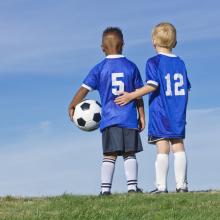injury

Photo via Brocreative / Shutterstock.com
DAVID KING and Margot Starbuck are nostalgic for the good ol’ days of youth sports. In Overplayed: A Parent’s Guide to Sanity in the World of Youth Sports, the authors first critique the current youth sports machine by reminiscing about an athletic utopia of the past: One where kids used water bottles for goal posts and flip-flops for bases. Back when parents weren’t paying up to $18,000 in hotel and trainer fees for elite travel teams. Back when kids loved sports.
This book intends to teach parents how to prevent burnout, overuse injury, and a misguided value system for their children. However, I read Overplayed as a young single woman learning to love sports again after suffering overuse injury and burnout right before college. I wish my parents—loving and good-intentioned as they were and are—had read this book 20 years ago.
King, athletic director at a Mennonite university, and Starbuck, a writer and a parent to three teenage athletes, believe that sports has the potential to be a powerful force in the lives of children. However, often money and myths corrupt that potential. Early on, Starbuck speaks wonders of the ways athletics teach us to know and love our physicality, explaining, “I came to know my body as good because of the opportunities I had to play sports as a girl.” But with early single-sport specialization and year-round tournament schedules, children are coming to know their bodies as injured before they can come to know their bodies as good. The authors note that in 2014, 1.35 million kids suffered sports-related injuries that landed them in the emergency room. “‘No pain no gain,’” the authors insist, “should have no place in youth sports.”
In the wake of the Boston Marathon bombings that left three dead and more than 260 injured, perhaps none face more significant adjustments or a longer road ahead than the 14 amputees who lost a limb.
For these victims, the path forward involves relearning almost everything, from getting out of bed to getting in a car. Whether they go on to lead satisfying lives depends largely on how they handle the spiritual challenges at hand, according to amputees and researchers.
Losing a limb is like losing a family member: It involves grief and mourning, according to Jack Richmond, a Chattanooga, Tenn., amputee who leads education efforts for the Manassas, Va.-based Amputee Coalition. When one’s body and abilities are radically changed, questions of meaning are suddenly urgent: Why did this happen? Why am I here?
“You’re wondering: Why did I live?” said Rose Bissonnette, an amputee and founder of the Lancaster, Mass.-based New England Amputee Association, a support organization for amputees.
I
The crumpled woman pushes through the door
and sees your plump limp limbs
held tight in my buckled arms.
She remembers holding
such sweet eternity.
There is nothing casual
about casualties of war.
It is serious business deciding
which of the wounded
get Medevac’d or left behind
on the battlefield.
It is not the ones
with the most severe of injuries
who are transported
elsewhere for treatment
but the ones with the best
chance of surviving them
that make the trip.
“There’s nothing we can do.”
Albania was perhaps the most closed society in the world during the Cold War, with absolutely ruthless persecution of all religion. Churches were destroyed in every corner of that country. Clergy were eliminated. Worship was outlawed. And enforcement was brutal.
When Communism fell, and the country opened for the first time in decades, the Albanian church began a miraculous process of rebirth. We heard the moving story of the Albania Orthodox Church, rebuilding countless church structures, but even more importantly, restoring faith in the hearts of its people. I've known its leader, Archbishop Anastasios, from past encounters at the World Council of Churches, and he surely is a saint. The revival of religious faith in Albania and its compassionate service to those in need is a magnificent story of the church's witness, and the Spirit's power.
